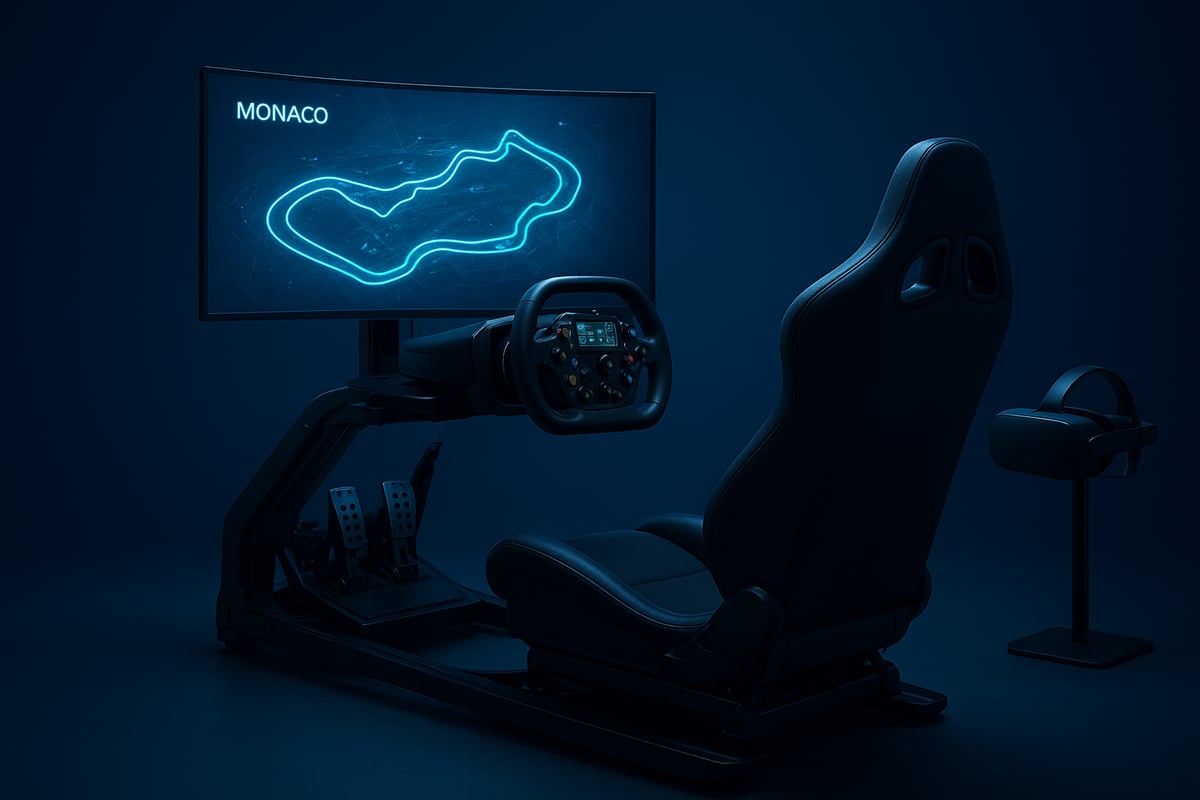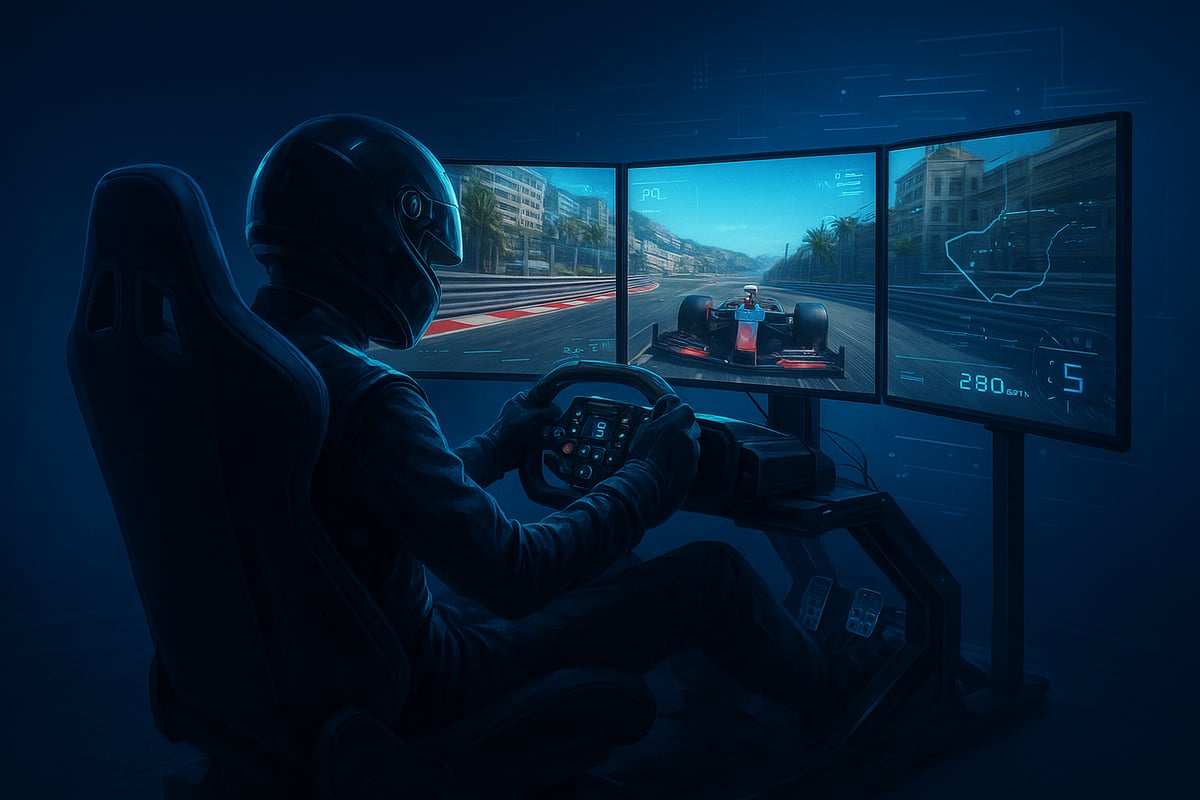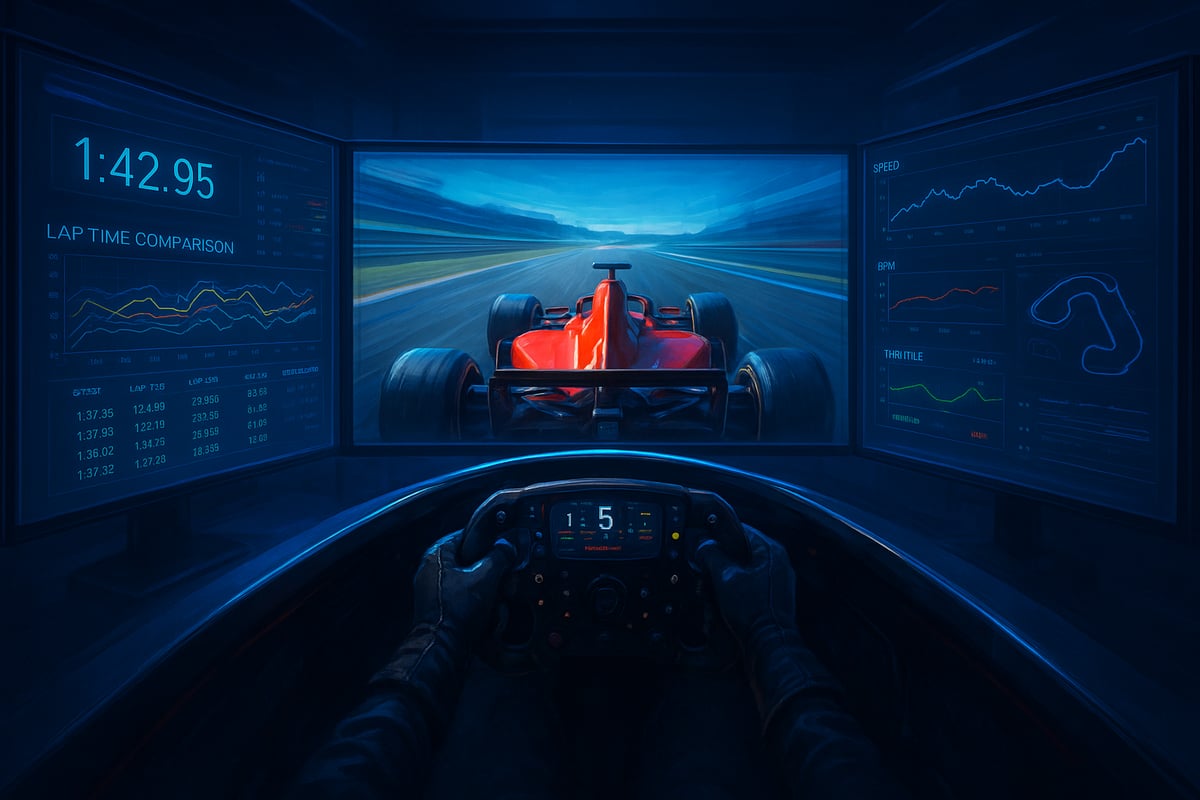
F1 Driving Simulator Guide: Master Every Lap in 2025
|
|
Ever wondered what it takes to master every lap like an F1 pro without even stepping outside your front door? The world of racing has changed, and the f1 driving simulator is now more realistic and popular than ever as we speed towards 2025.
With this guide, you're about to unlock everything you need to get the most out of your simulator, whether you're just starting out or already chasing lap records. We'll cover the simulator essentials, help you fine-tune your setup, dive into advanced driving techniques, and explore the latest simulation trends for 2025.
Get ready to experience the thrill, sharpen your skills, and take action step by step. Your journey to F1 mastery starts right here.
Have you noticed how the world of F1 driving simulator technology has shifted gears recently? The changes are massive. Let’s break down what makes simulators in 2025 so compelling, whether you’re just starting or already chasing lap records.

The last five years have been a true revolution for the f1 driving simulator scene. Back in 2020, simulators were already popular, but now, the realism is on another level. Improvements in physics engines and graphics mean you feel every vibration and see every detail.
Esports exploded, making f1 driving simulator competitions accessible worldwide. Even real F1 teams now use advanced simulators for car development and driver training. The line between virtual and real racing has never been thinner.
Today’s f1 driving simulator systems are packed with features that make you feel like you’re on the grid. Imagine laser-scanned tracks, capturing every bump at Monaco, and high-fidelity car models that react just like the real thing.
Advanced force feedback lets you sense tyre grip.
Motion systems simulate G-forces.
VR and multi-screen support pull you right into the action.
This level of immersion makes every lap feel authentic, down to the smallest kerb.
To get the most from your f1 driving simulator, you’ll need the right gear. Basics include a steering wheel, pedal set, sturdy seat, and a stable rig. Entry-level setups work for beginners, while pros might invest in direct drive wheels and custom cockpits.
Entry: Clamp-on wheels and foldable seats.
Pro: Motion platforms, load cell pedals.
Compatibility: PC and console support.
Popular wheels like the Logitech G923 are staples in F1 esports, offering a great balance of feel and price.
The software you choose defines your f1 driving simulator experience. Top titles like Assetto Corsa, rFactor 2, and F1 2025 lead the pack with realism, mod support, and online features. Licensing is key—official F1 cars and tracks make the difference.
If you want to explore the most up-to-date options, check out the Best F1 simulator games 2025 for a full rundown on what’s hot right now.
FIA-licensed content means you’re racing on the same circuits as your favourite drivers.
A f1 driving simulator isn’t just for pros. Anyone can jump in, practice, and build skills safely from home. Advanced techniques are easy to try without risk, and the online community is welcoming.
Safe space for learning.
Compete or just have fun.
Track your progress over time.
Did you know sim racing participation has jumped 30% since 2022? There’s never been a better time to get involved.
Ready to bring the thrill of the F1 circuit into your living room? Building your ultimate f1 driving simulator rig is all about matching your ambitions, space, and budget. Let’s break down the essentials and help you set up a rig that feels just right for your skills and goals.

Your f1 driving simulator journey starts with choosing the right gear. Think about your available space, whether you’re squeezing into a cosy apartment or dedicating a full room. Entry-level setups might include a simple wheel and pedal set, while pro rigs feature direct drive wheels and sturdy cockpits. Adjustable seating and pedal positions make a difference, so comfort should always be a priority.
Curious which cockpit is best for your needs? Check out the Best racing simulator cockpits guide for a helpful comparison.
Ever wonder why pro sim racers spend so much time tweaking their seat position? Ergonomics matter in any f1 driving simulator, especially for those long practice stints. Start by aligning your seat so your legs and arms are slightly bent. Adjust wheel height and angle for a natural grip. Keep your pedals at a comfortable distance to avoid strain on your ankles and knees.
A good setup helps you stay focused and reduces fatigue, making every session more enjoyable.
Once your core f1 driving simulator rig is dialled in, it’s time to consider upgrades. Think about adding:
Monitor stands or triple-screen setups for wider views
Surround sound or quality headphones for immersion
VR headsets for next-level realism
Haptic feedback or motion platforms for tactile sensations
Cable management solutions to keep things tidy
Choosing the right accessories can take your sim racing experience from good to great.
Software is the heart of any f1 driving simulator. Install and update your chosen simulation platform, then calibrate your wheel and pedals for accurate feedback. Fine-tune force feedback settings to match your driving style and adjust graphics for the best blend of performance and immersion. Reducing input lag is crucial for competitive play, so don’t overlook these tweaks.
A well-calibrated setup lets you feel every kerb and corner, just like the pros.
Think of your racing space as your personal pit lane. Soundproofing can help block out household noise, while adjustable lighting reduces screen glare and eye strain. Keep your space free from interruptions by setting up a dedicated sim racing area, even if it’s just a corner of your room.
Did you know? Drivers with distraction-free setups have reported up to 40% better performance. A focused environment makes every lap count.
Ready to take your racing to the next level? Mastering an f1 driving simulator is all about blending precision, consistency, and mental sharpness. Whether you’re chasing your first clean lap or eyeing the podium in online leagues, refining your technique is the fastest way to see your lap times drop and your confidence soar.

Every great lap in an f1 driving simulator starts with mastering the basics. The racing line is your path to speed, dictating where you position the car for each corner. Focus on braking points—brake early, then gradually push your limits as you gain confidence.
Smooth inputs with the wheel and pedals are crucial. Jerky steering or stabbing the brakes can cost precious tenths. Watch telemetry or replay data to see how a clean line through a corner can shave seconds off your lap. Even small improvements in these fundamentals can transform your overall pace.
Start slow, aiming for accuracy over outright speed. In an f1 driving simulator, consistency is your best friend. Break the circuit into sectors and work on each one at a time. This way, you can pinpoint where you’re losing time and focus your practice.
Use ghost laps and lap splits as benchmarks. Chasing your best sector times helps you build a rhythm and spot where you can push harder. Many sim racers find that by mastering sector 2 at Spa, for instance, they can unlock big improvements across the whole lap.
Once the basics are second nature, advanced skills unlock even more speed in your f1 driving simulator. Trail braking lets you carry more speed into corners by gently releasing the brakes as you turn in. Throttle control is key when exiting slow turns—squeeze the power on smoothly to avoid spinning up the tyres.
Understanding weight transfer helps you balance the car and stay in control under pressure. Many F1 esports finalists rely on these techniques to stay ahead. If you want to take immersion and technique learning up a notch, check out the Ultimate VR sim racing guide for tips on using VR to feel every nuance of your driving.
Realism in modern simulators means you’ll face changing weather, track temperatures, and tyre wear. In an f1 driving simulator, you’ll need to tweak your driving style for wet or dry conditions. Practice smooth throttle and brake modulation when grip is low.
Basic setup tweaks—like adjusting downforce or tyre pressures—can make your car feel more stable or agile. Sim platforms like F1 2025 make rain races a true test of adaptability, so don’t be afraid to experiment and adjust on the fly.
Staying sharp mentally is just as important as physical technique. Use visualisation and mental rehearsal before sessions in your f1 driving simulator. This helps you build confidence and reduce nerves, especially in competitive online races.
Practice overtaking and defensive moves, as racecraft is often the difference between winning and spinning. Top sim racers dedicate more than 10 hours a week to mental focus drills, proving that mindset is a powerful tool for improvement.
Every session is a chance to get better. Review your replays and telemetry data to spot patterns—maybe you’re braking too late or missing apexes. Identify your most common errors and set clear, achievable goals to target them.
By turning mistakes into lessons, you’ll keep progressing and enjoy every lap just a bit more.
Unlocking your potential in an f1 driving simulator goes beyond just putting in laps. Analysing your on-track data is the secret sauce that separates casual racers from the front runners. By diving into telemetry, you’ll spot patterns, find areas to improve, and make real gains—just like the pros.

If you’re keen to get faster in an f1 driving simulator, telemetry is your best friend. Telemetry is the digital record of every input and output your virtual car makes—speed, throttle, brake, and steering. By reviewing these numbers, you can pinpoint where you lose time or where you’re already nailing it.
For example, reviewing your braking data can reveal if you’re consistently stopping too early or late into corners. This insight gives you a clear direction for your next practice session.
Most modern f1 driving simulator titles include built-in telemetry tools, but third-party apps can take your analysis to the next level. Overlay software lets you compare your laps in real time, and many platforms allow exporting data for deeper dives.
For PC racers, F1 25 PC Features offers advanced telemetry export, graphical overlays, and compatibility with data analysis tools like MoTeC or VRS. These features help you visualise your driving and make informed adjustments.
Ready to use your f1 driving simulator data for real progress? Start by recording a clean baseline lap. Then, compare subsequent laps to spot trends—like where you’re gaining or losing time. Make small, focused changes in your driving or car setup, then check if your data reflects improvement.
Here’s a quick process:
Record a baseline lap
Review throttle, brake, and steering traces
Set one or two improvement targets
Repeat, analysing after each session
Benchmarking is key for any aspiring f1 driving simulator ace. Download pro ghost laps or world record telemetry files from your favourite sim platform. Compare their data with yours—look at braking points, throttle application, and sector times.
Notice how the fastest drivers approach tricky corners or manage acceleration. By studying their telemetry, you can adopt their techniques and close the gap lap by lap.
Keeping tabs on your progress is crucial for long-term growth. Log your lap times, sector improvements, and personal bests. Celebrate each milestone, no matter how small. Regular review of your data keeps you motivated and focused on steady improvement.
Did you know that drivers who routinely review their sim data improve 25% faster than those who don’t? Consistency and reflection are your tickets to mastering every lap.
Ready to peek into the future of your f1 driving simulator journey? The next wave of sim racing is packed with boundary-pushing tech, new ways to immerse yourself, and a community that’s bigger and more inclusive than ever. Let’s break down what’s coming for 2025 and how you can make the most of it.
Picture this: your f1 driving simulator now beams out photorealistic tracks, complete with ray tracing and realistic weather. The physics engines have reached a point where every bump, kerb, and tyre squeal feels just right. Motion platforms and haptic systems let you sense the car’s weight shift and every subtle change in grip.
For those who want to push their setup even further, check out this Motion sim racing guide 2025 for expert advice on motion systems and sensory upgrades. Imagine adaptive AI that learns your driving style and real-world data feeding into your sim for unmatched realism.
If you thought VR was impressive before, wait until you see what’s on the horizon for f1 driving simulator fans. Next-gen VR headsets offer wider fields of view, higher resolution, and near-zero latency. Motion rigs sync perfectly with your virtual world, so you truly feel every corner.
Augmented reality overlays can project racing lines, braking points, or even live coaching tips right into your view. Some F1 teams are already using AR and VR for training, so you’re in good company as a home sim racer.
The f1 driving simulator scene has exploded with global online leagues, bringing together rookies and pros alike. Esports events are drawing in massive audiences, with record-breaking online viewership in 2024. You can join official F1 esports competitions or race in grassroots leagues, all from your lounge room.
Social features like voice chat, live spectating, and community-built events mean you’re never racing alone. The barrier to entry has dropped, so anyone can jump in and compete, regardless of experience.
Sim racing in 2025 is more welcoming than ever. Developers are rolling out adaptive controls for people with different abilities, and there’s a strong push for diversity across the community. Initiatives supporting female racers and underrepresented groups are making a real impact.
Since 2022, there’s been a 15 percent rise in female participation in sim racing. This means your f1 driving simulator experience is now part of a much broader, more supportive community, where everyone can chase their racing dreams.
Want your rig to keep up with the pace of innovation? Modular hardware is your best friend. Swappable wheels, pedals, and motion modules let you upgrade as new tech drops. Make sure your software stays current so you can enjoy the latest features and compatibility.
If you’re unsure where to start, check out this Pro-Grade F1 Simulators Ranked for 2025 guide for a rundown of top rigs and future-proofing tips. Staying adaptable means your f1 driving simulator will always be ready for what’s next.